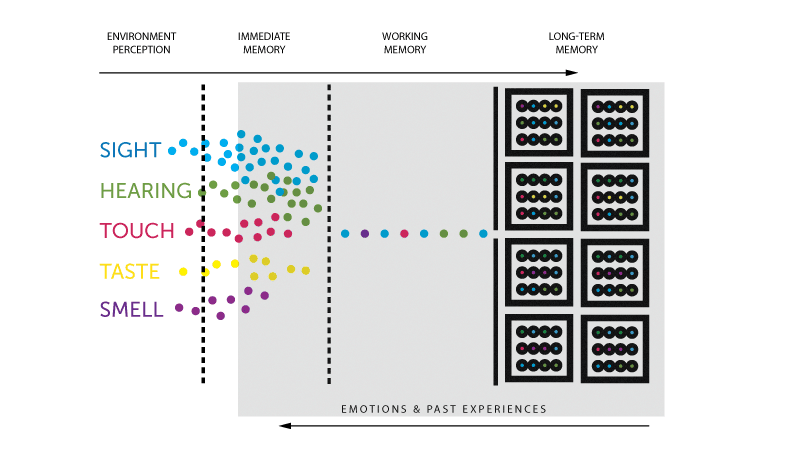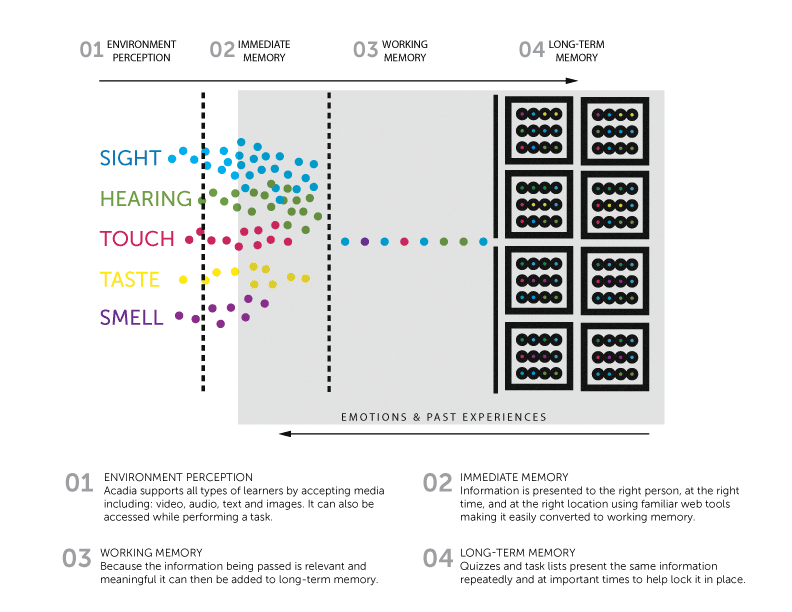Help your team be more productive & efficient
Deploy process training that matches the way they neurologically learn.

Our teams are frequently being asked to achieve more productivity with less resources while their jobs are becoming more complex. If you have standardized operational procedures and want to effectively train your team on them, first you need to understand the basics of how they learn.
By incorporating these practices into your training, you’re more likely to get the information to stick and achieve the behavior change you’re looking for.
Learning in the workplace
Lots of things happen to you during the course of a workday. Information is constantly presented to you and without purposely thinking about it, your brain makes decisions about whether or not to hang on to that information. You review it in context of what you understand about your job, your company, and your industry. If the information fits into that context, it will likely have meaning for you. If you can envision it applying to your personal work, then it is relevant for you. With both boxes checked, the information is a candidate for long-term memory storage.
Another important aspect of learning is repetition or practice. Activities performed at work are really no different than riding a bike or playing a musical instrument. As you practice an activity, you become more efficient at it. When the same information is presented to your brain with repetition, it begins to develop physical and chemical changes that relate to the activity. Eventually, the activity can be performed reflexively as the brain builds a pattern that is automatically recalled when you perform the task.
While in-person training sessions are valuable at introducing information, the brain will only retain certain portions of it, and only for a short period of time. If the pattern of information is repeated while it is still fresh, then it is much more likely that it will pass into long-term memory.
The trick is making sure that the same materials are used throughout the learning process and well into the performance of the task. Repeating the task the same way multiple times helps to make it stick. (That’s the third time – did we make it stick?)
Keys to helping employees learn:
- Make the information meaningful and relevant.
- Present it in a clear and actionable manner, leaving the employee with the expectation that this will help them succeed.
- Engage as many senses as possible with the material.
- Give them the information in context, ideally while they are performing the task.
- Make the information part of the task so that it is repeated each time and the employee knows s/he is responsible for it.
- Check for comprehension to ensure the most important information has been retained.
How do we know this works? Because that’s how our brains work. If we train the same way our brains work, we’ll get more to stick.
How the brain sorts inbound data
Fortunately, most of our brains work the same way. So, we can take what neuroscientists have discovered and apply it to learning at work.
Learning begins when new information is introduced to us through our senses. Actually, data enters our brain at a dizzying pace. Take a moment to try to notice all the external forces impacting your current environment.
What sounds can you hear? What do you see as you look around? What’s the temperature? What can you smell?
Your brain takes in every single one of the hundreds and thousands of signals around you. Thankfully, you don’t have to think about each of these signals individually and decide how to react to them.

As information enters your brain through your senses, it is stored in your immediate memory. Here, your brain makes quick (millisecond) judgements – based on previous experiences – about whether to further review the information or discard it.
For example, if you see an ambulance coming with lights and sirens going, you immediately take notice. You assess the situation and decide what to do based on previous experience. But if a car passes slowly past your house, you probably don’t even hear it.
Once the brain discards something, it’s gone for good.6 However, if based on previous experiences, your brain decides the information needs additional attention, it is passed along to your working memory.
In your working memory, your brain makes a lot of decisions, so it can only process a few things at a time. Your working memory determines whether a piece of information is:
- something to simply discard – you passed 12 blue cars in the parking lot on your way in
- something that you should maintain for a short period – where did I park?
- something that is compelling enough to make a permanent part of you – I drive a black Ford F-150
Which memories become part of you
Every new input that your brain processes is filtered through your past experiences. The information the brain readily passes into long-term memory relates to survival, or your most vivid emotions. So typically, the best and worst things that happen to you become long-term memories fastest and easiest.
For most of us, the best and worst moments of our lives don’t happen, on a regular basis, during our work life. Fortunately, the brain has another standard for entering information into long-term memory. The other process performed in working memory is an assessment of whether the information makes sense and whether it has meaning.6 If information makes sense, that means it fits into the way you understand the world. If information has meaning, then it is relevant to you.
Tools built on these principles
The way we learn is deeply ingrained in our biology. It is counter-productive to attempt to train in any way that conflicts with these basic facts.
From the beginning, the fundamental nature of how the brain learns has served as the compass for developing the Acadia Performance Platform. Each phase of the memory process has been accounted for, and improvements have been made over time based on our customers’ feedback.

All knowledge entered into the Acadia platform can be retrieved by employees using simple and intuitive online tools – tools they are accustomed to using in their daily lives. This triggers emotions from past successful experiences and puts the employee in the proper mindset for learning.
All materials used in training (step-by-step instructions, images, video, etc.) can be added to documents in Acadia, making sure they are easily accessible while performing activities. By seeing these materials multiple times, it reinforces the correct behavior and helps to generate long-term memories.
Similarly, procedures can be automatically converted to auditable task lists that employees can use on mobile devices while performing activities. With a consistent and structured approach to each important procedure, the One Best Way to perform it becomes adopted quickly and easily.
Assessing comprehension, through quizzing, after learning something new can further help to engage long-term memory. It reinforces the most important material and helps make the employee accountable.
Finally, and perhaps most importantly, employees can provide feedback on every document to suggest better, more efficient ways of performing tasks. Making an employee part of the process not only encourages a culture of continual improvement, it also helps them to think more critically about their work and makes each learning experience a positive one.
Read on:
Capturing One Best Way work procedures

(We promise the hot dog will make sense).
Sources:
- The World Is More Complex than It Used to Be
- Simplification of work: The coming revolution
- History of employee engagement – from satisfaction to sustainability
- The overwhelmed employee: Simplify the work environment
- 4 Reasons Why Deploying A Learning Management System Is More Trouble Than It’s Worth
- How the brain learns 5th edition, David A. Sousa (p. 45-49, 57, 93, 61)
"*" indicates required fields
Ready to crush your goals?
"*" indicates required fields